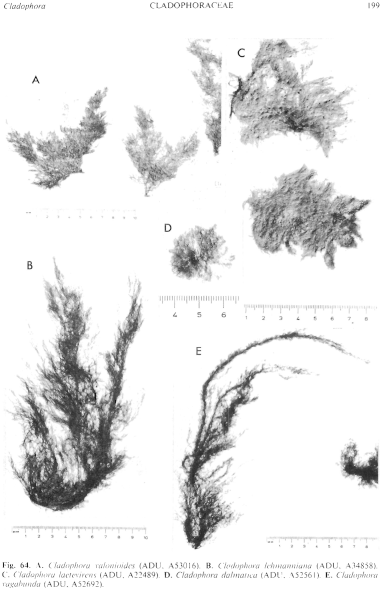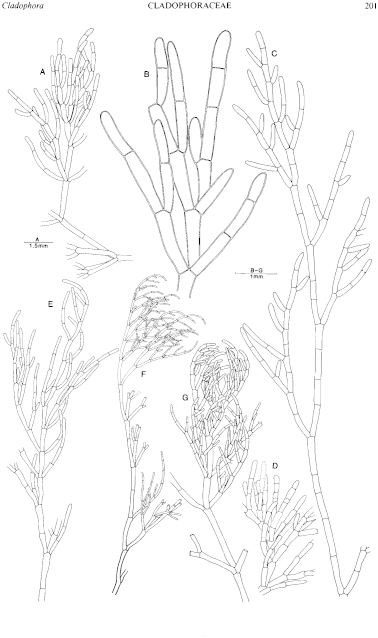|
|
|
|
|
|||||||||||
|
Electronic Flora of South Australia Species Fact Sheet
Phylum Chlorophyta – Order Cladophorales – Family Cladophoraceae
Synonyms
Cl. fascicularis (Mertens ex C. Agardh) Kützing. Womersley 1956: 358.
Cl. ceratina Kützing 1845: 210. Womersley 1956: 360.
Cl. daveyana Reinbold 1899: 40. Lucas 1936: 29.
Thallus (Fig. 64E) light to medium green, forming densely branched tufts 2–6 cm high of fasciculate branch systems or more elongate strands 4–30 cm high, with numerous pseudodichotomous axes attached by rhizoids from the basal region, usually occurring under calm to moderate water movement, epilithic or sometimes epiphytic, also forming diffuse loose masses or attached plants in lagoons and saltmarsh ponds; filaments branched from almost every cell above with slightly falcate or straight and usually unilateral fascicles (Fig. 65G), with the filaments increasing markedly in diameter shortly below the apical cells or just below the fascicles; in lagoon plants these fascicles are less distinct. Growth acropetal and mainly apical above, with intercalary divisions in the mid and lower thallus cells thus separating the laterals by 2–8 or more cells, with occasional intercalated laterals arising below new cross walls; especially in lagoon plants this intercalary growth may be conspicuous; parent cells bearing 1–3 (–6) laterals at acute to (usually) broad angles; basal cross walls of laterals oblique to parent cells, becoming later almost horizontal.
Apical cells (25–) 30–50 (–70) µm in diameter, L/B 2–16, cylindrical or often tapering, with rounded apices; ultimate branch cells 25–90 µm in diameter, L/B 2–17; lower thallus cells 85–215 µm in maximum diameter (mostly about 150 µm), L/B 1.5–10; ratio of mid and lower cell to apical cell diameters 2–4 (–6); pale plants from lagoons and saltmarsh ponds tend to be slenderer and longer celled; cell walls 1–3 µm thick above, becoming 10–15 µm thick and lamellate below.
Reproduction: Reproduction by apical and subapical cells forming zooidangia; in Europe, by biflagellate gametes and quadriflagellate zoospores (van den Hoek 1963, p. 149).
Type from Selsey, England; in OXF (see van den Hoek 1963, pp. 19, 144).
Selected specimens: Point Drummond, S. Aust., mid eulittoral sheltered pool (Womersley, 11.i.1951; ADU, A15024). Coffin Bay, S. Aust., upper sublittoral on flats (Womersley, 10.i.1951; ADU, A13632). Barker Rocks, Yorke Pen., S. Aust., 0.5–1 m deep, on Cladostephus (van den Hoek 81/65, 20.ix.1981). Coobowie, Yorke Pen., S. Aust., at outflow within lagoon (van den Hoek 81/55, 18.ix.1981; ADU, A52692). American R. inlet, Kangaroo I., S. Aust., on sides of red buoy (Womersley, 25.i.1946; ADU, A3469). North Arm, Port Adelaide, 0.1–0.5 m deep, on pontoons of Commercial Fishing Marina (van den Hoek 81/69, 1.x.1981; ADU, A52643). Coorong, S. Aust., in shallow water 38 km S. of Meningie (Womersley, 31.xii.1981; ADU, A52834). Robe, S. Aust., in drain outlet (Womersley, 31.i.1951; ADU, A52144). Fawthrop Lagoon, Portland, Vic., on stones, shallow, very calm (Womersley, 29.xii.1981; ADU, A52862, A52861). Apollo Bay, Vic., in shallow, brackish lagoon (van den Hoek 81/16, 1.ix.1981; ADU, A52678). Opossum Bay, Port Arthur, Tas., on shell (Cribb 125.4, 5.ii.1951; HO, 44875).
Distribution: Cosmopolitan in tropical and temperate waters, on sublittoral and lower eulittoral rocks, in rock pools, in lagoons and saltmarsh ponds.
From north of Perth (e.g. from N.W. Cape), W. Aust., around southern Australia and Tasmania to Bowen, Old. Probably a widely distributed species on most coasts of Australia.
Taxonomic notes: Cl. vagabunda is closely related to Cl. dalmatica, differing in its greater diameters and in the marked increase in filament diameter within the upper fascicles though this is less clear in pale plants from lagoons and saltmarsh ponds.
References:
KÜTZING, F.T. (1845). Phycologia Germanica. (Köhne: Nordhausen.)
LUCAS, A.H.S. (1936). The Seaweeds of South Australia. Pt. I. Introduction and the Green and Brown Seaweeds. (Govt Printer: Adelaide.)
REINBOLD, T. (1899). Meeresalgen von Investigator Street (Sud Australien), gesammelt von Miss Nellie Davey (Waltham, Honiton). Hedwigia 38, 39–51.
VAN DEN HOEK, C. (1963). Revision of the European species of Cladophora. (Brill: Leiden.)
VAN DEN HOEK, C. (1982). A taxonomic revision of the American species of Cladophora (Chlorophyceae) in the North Atlantic Ocean and their geographic distribution. Verh. k. Ned. Akad. Wet. Afd. Natuurkd. Tweede Reeks, Part 78.
WOMERSLEY, H.B.S. (1956). A critical survey of the marine algae of southern Australia. I. Chlorophyta. Aust. J. mar. freshw. Res. 7, 343–383.
The Marine Benthic Flora of Southern Australia Part I complete list of references.
Publication:
Womersley, H.B.S. (31 May, 1984)
The Marine Benthic Flora of Southern Australia
Part I
©Board of the Botanic Gardens and State Herbarium, Government of South Australia
Illustrations in Womersley Part I, 1984: FIGS 64E, 65G.

Figure 64 enlarge
Fig. 64. A. Cladophora valonioides (ADU, A53016). B. Cladophora lehmanniana (ADU, A34858). C. Cladophora laetevirens (ADU, A22489). D. Cladophora dalmatica (ADU, A52561). E. Cladophora vagabunda (ADU, A52692).

Figure 65 enlarge
Fig. 65. A,B. Cladophora valonioides (A, Isotype in TCD; B, ADU, A50892). A. Upper branch system. B. Upper branches to same scale as C–D. C–D. Cladophora lehmanniana (C, ADU, A52670; D, ADU, A52616). C. Upper branch system. D. Upper reproductive cells. E. Cladophora laetevirens (ADU, A22489). Upper branch system. F. Cladophora dalmatica (ADU, A52561). Upper branch system. G. Cladophora vagabunda (C. van den Hoek 81/65). Upper branch system.

|
Email Contact: State Herbarium of South Australia |

|